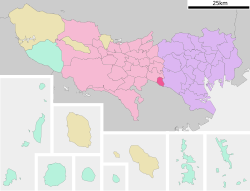Komae, Tokyo
|
Komae 狛江市 |
|||
|---|---|---|---|
| City | |||

Komae City Hall
|
|||
|
|||
 Location of Komae in Tokyo |
|||
| Coordinates: 35°38′5.2″N 139°34′43.3″E / 35.634778°N 139.578694°ECoordinates: 35°38′5.2″N 139°34′43.3″E / 35.634778°N 139.578694°E | |||
| Country | Japan | ||
| Region | Kantō | ||
| Prefecture | Tokyo | ||
| Government | |||
| • Mayor | Kunihiko Takahashi (since July 2012) | ||
| Area | |||
| • Total | 6.39 km2 (2.47 sq mi) | ||
| Population (February 2016) | |||
| • Total | 81,671 | ||
| • Density | 12,780/km2 (33,100/sq mi) | ||
| Time zone | Japan Standard Time (UTC+9) | ||
| Symbols | |||
| • Tree | Ginkgo biloba | ||
| • Flower | Azalea | ||
| Phone number | 03-3430-1111 | ||
| Address | 1-1-5 Izumi-Honcho, Komae-shi, Tokyo 201-8585 | ||
| Website | www |
||
Komae (狛江市 Komae-shi?) is a city located in the western portion of Tokyo Metropolis, in the central Kantō region of Japan. It is one of 30 municipalities in the western portion of Tokyo known as the Tama Area. As of 1 February 2016[update], the city had an estimated population of 80,464 and a population density of 1100 persons per km². Its total area was 6.39 square kilometres (2.47 sq mi). It is the smallest administrative city in Tokyo Meotropolis both in area and population, and the second smallest in terms of area in the nation.
Komae is nestled between the Tama River to the southwest, and the much smaller Nogawa river to the north and east which flows near its boundaries with Chōfu city and Setagaya Ward. It is mostly flat. It is a small municipality; its boundaries fit within a circle of 2 km radius centred on the city hall. It is essentially a residential suburb of Tokyo which urbanised rapidly in the 1960s and 1970s, with most of the working population commuting to central Tokyo. There are several neighbourhood shopping areas, mainly around the train stations. The City Hall is located near Komae Station.
The city's name is thought to originate from the word koma, referring to migrants, especially Goguryeo from the Korean peninsula who settled here around the 5th century AD. Numerous kofun burial mounds are located within the city borders.
...
Wikipedia



